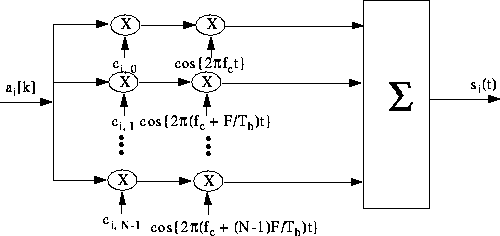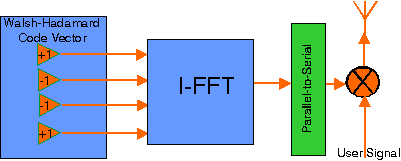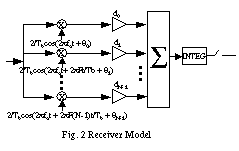
 |
JPL's Wireless Communication Reference WebsiteChapter: Analog and Digital Transmission
|
 This
scheme was first proposed at PIMRC '93 in Yokohama by Linnartz, Yee (U. of California
at Berkeley) and Fettweis (Teknekron, Berkeley, currently at U. of Dresden,
Germany). Independently, Fazal and Papke proposed a similar system. Linnartz
and Yee showed that MC-CDMA signals can also be detected with fairly simple
receiver structures, using an FFT and a variable gain diversity combiner, in
which the gain of each branch is controlled only by the channel attenuation
at that subcarrier. At PIMRC '94 in The Hague, optimum gain control functions
were presented. Results showed that a fully loaded MC-CDMA system, i.e., one
in which the number of users equals the spread factor, can operate in a highly
time dispersive channel with satisfactory bit error rate. These results appeared
in contrast to the behaviour of a fully loaded DS-CDMA link that typically does
not work satisfactorily with large time dispersion.
This
scheme was first proposed at PIMRC '93 in Yokohama by Linnartz, Yee (U. of California
at Berkeley) and Fettweis (Teknekron, Berkeley, currently at U. of Dresden,
Germany). Independently, Fazal and Papke proposed a similar system. Linnartz
and Yee showed that MC-CDMA signals can also be detected with fairly simple
receiver structures, using an FFT and a variable gain diversity combiner, in
which the gain of each branch is controlled only by the channel attenuation
at that subcarrier. At PIMRC '94 in The Hague, optimum gain control functions
were presented. Results showed that a fully loaded MC-CDMA system, i.e., one
in which the number of users equals the spread factor, can operate in a highly
time dispersive channel with satisfactory bit error rate. These results appeared
in contrast to the behaviour of a fully loaded DS-CDMA link that typically does
not work satisfactorily with large time dispersion.
Since 1993, MC-CDMA rapidly has become a topic of research. At the keynote address of the ISSSTA conference 1996, Prof. Hamid Aghvami predicted that the hottest topic in spread-spectrum, viz. multi-carrier cdma, would attract 80% of the research by 1997. Around 2000, we see that MC-CDMA has attracted tremendous attention, with entire conference sessions devoted to this. Mc-CDMA is praised as a modulation solution that merges the insights due to Shannon (particularly those relating to CDMA) with insights due to Fourier (particularly those explaining why OFDM has advantages in a dispersive channel).
The MC-CDMA method described here is NOT the same as DS-CDMA using multiple carriers. In the latter system the spread factor per subcarrier can be smaller than with conventional DS-CDMA.
Such a scheme is sometimes called MC-DS-CDMA. This does not use the special OFDM-like waveforms to ensure dense spacing of overlapping, yet orthogonal subcarriers.
MC-DS-CDMA has advantages over DS-CDMA as it is easier to synchronize to this type of signals.
Possible Transmitter Implementation
 | Figure: possible implementation of an Multi-Carrier spread-spectrum transmitter. |
MC-Code Division Multiple Access systems allow simultaneous transmission of several such user signals on the same set of subcarriers. In the downlink multiplexer, this can be implemented using an Inverse FFT and a Code Matrix.

Figure: FFT implementation of an MC-CDMA base station multiplexer and transmitter.

The above transmitter can also be implemented as a Direct-Sequence CDMA transmitter, i.e., one in which the user signal is multiplied by a fast code sequence. However, the new code sequence is the Discrete Fourier Transform of a binary, say, Walsh Hadamard code sequence, so it has complex values.

Figure: Alternative implementation of a Multi-Carrier spread-spectrum transmitter, using the Direct sequence principle.
 Because of delay spread and frequency dispersion due to multipath fading, subcarriers are received with different amplitudes. An importance aspect of the receiver design is how to treat the individual subcarriers, depending on their amplitude ri. Options are
Because of delay spread and frequency dispersion due to multipath fading, subcarriers are received with different amplitudes. An importance aspect of the receiver design is how to treat the individual subcarriers, depending on their amplitude ri. Options are
The first paper on Multi-Carrier CDMA appeared in 1993:
[93-C4] N. Yee, J.P.M.G. Linnartz and G. Fettweis, "Multi-Carrier CDMA in indoor wireless Radio Networks", IEEE Personal Indoor and Mobile Radio Communications (PIMRC) Int. Conference, Sept. 1993, Yokohama, Japan, pp. 109-113. PDF 2.8MB | PDF LInnartz PIMRC 93 MC CDMA
N. Yee and J.P.M.G. Linnartz, "Multi-Carrier in an indoor wireless radio channel", Memorandum UCB/ERL M94/6, U.C. Berkeley, 1994. http://www.eecs.berkeley.edu/Pubs/TechRpts/1994/ERL-94-6.pdf (UCB bib data) (The original U.C. Berkeley Technical report)
[94-C10] PS PDF PDF2 N. Yee and J.P.M.G. Linnartz, "Wiener filtering for Multi-Carrier CDMA", IEEE / ICCC conference on Personal Indoor Mobile Radio Communications (PIMRC) and Wireless Computer Networks (WCN), The Hague, September 19-23, 1994, Vol. 4, pp. 1344-1347.
PDF J.P.M.G. Linnartz, "Performance Analysis of Synchronous MC-CDMA in mobile Rayleigh channels with both Delay and Doppler spreads", IEEE VT, Vol. 50, No. 6, Nov. 2001, pp 1375-1387.